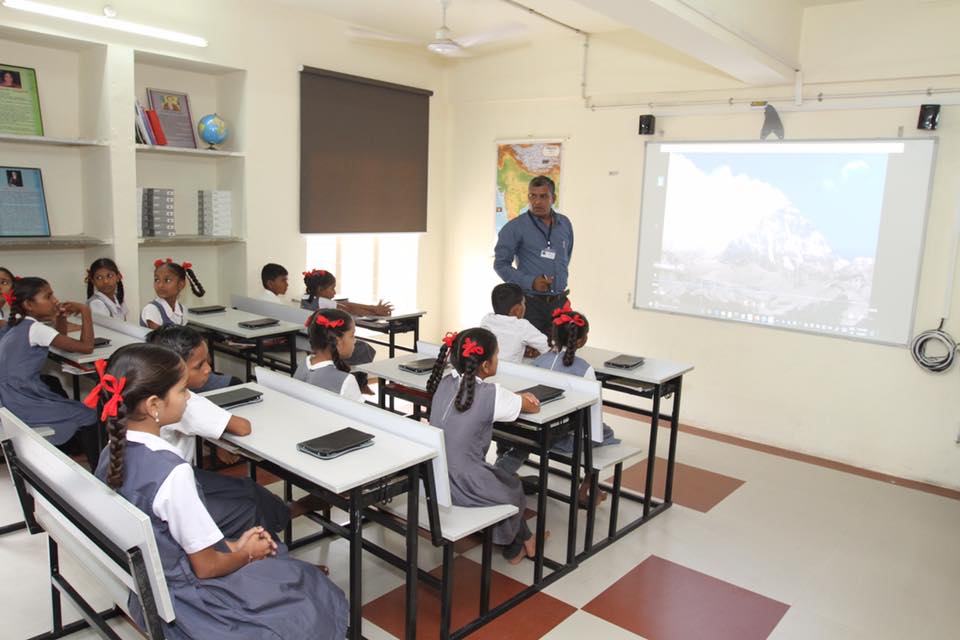75 students left private school to join smart class in govt primary school in Vadodara district
September 03, 2022
By Darshan Trivedi
Vadodara: The Vadodara district administration has launched a unique campaign to showcase the quality outcomes of the smart class that are being offered to primary schools involving the community. Students from private schools have joined government primary schools as a result of the implementation of smart class in the district’s primary schools. 75 of these pupils have stopped attending private schools and resumed their studies in public elementary schools.
This initiative to implement a smart class in the state-run primary schools situated in the inner regions of the Vadodara district has been started by collector Atul Gor. The admirable goal of this initiative is to use technology to ensure that pupils in remote locations also receive a high-quality education. The district’s 225 schools have been chosen for this and 73 schools are included in the initial round of smart classes.
75 students left private school to join smart class in govt primary school in Vadodara district https://t.co/0XzGwGy2TM pic.twitter.com/3UspbgpD16
— DeshGujarat (@DeshGujarat) September 3, 2022
In this smart class, a dashboard is provided along with the educational module. It uses audio-visual media for its courses of various standards. There are animated math and science exercises as well as poems in Gujarati and Hindi with songs. That’s attracting students to learn with interest.
The story of Karajan Taluka’s Lilod village is fascinating. From that point on, pupils from private schools have been readmitted as soon as smart classes at government elementary schools began. The primary school in Lilod village, which has a population of only 900, has a total enrollment of 304 kids. Students from nearby villages attend this elementary school because the teachers are so committed to the cause of education. Following the start of these smart classes, 13 kids returned to public school. A private school in the nearby village is now about to shut down due to the implementation of the smart class, in addition to the state government opening a secondary school in Lilod.
I often check on my daughter Krishna’s academic progress, claims farmer Jaydevbhai Patnawadia, who transferred his child from a private school to this government elementary school. Compared to studying in a private school, his daughter prepared notes better in a government school and also obtain high term exam marks as well.
Assistant teacher Mahendrabhai Mehra says, we make the students of classes 6 to 8 study in the smart class. A total of 210 students study in these three standards in the school. Smart learning has increased students’ interest in studies. These students have shown good results in the unit test too.
Chirag Solanki, an assistant teacher in the Smart Class at Mota Habipura Primary School in Dabhoi Taluka, says the educational module has made teaching much simpler. Experiments in science can be easily described. Due to the fact that it is an audio-visual medium, kids also study with tremendous interest.
A total of 186 children study in Mota Habipura Primary School, and out of them a total of 54 students of classes seven and eight are taught in the smart class. 10 students from the village re-enrolled in the school after the smart class was installed by the district administration.
Harshadbhai Mohanbhai Patel, a farmer, has re-enrolled his daughter in the state-run primary school. He claims that my daughter’s ability has risen as a result of her attendance at this school, and she does her homework properly. Her enthusiasm for learning too has grown.
District primary education officer Archana Chaudhari said we conducted a survey that included 5853 pupils from Gyankunj’s 140 present schools. These sixth-grade kids had a bad annual exam performance because they did not learn in smart classes during the 2019–20 academic years. 982 pupils, or 17%, had a grade below 40%. A total of 4007 pupils received grades ranging from 40 to 79 percent. Only 750 pupils received a grade of greater than 80%.
These pupils are still the same ones that were in the Gyankunj class in grade 8 in 2021–2022, and their performance in the ensuing annual exam has improved. This year, 5853 students signed up in total. The percentage of pupils who received a 40 percent grade in the study has decreased to 12 percent after attending Gyankunj. The proportion of pupils scoring in the 40 to 80 percent range has increased to 69%. In the meantime, the percentage of students scoring more than 80% on the yearly exam rose by 6% to 18%. As a result, more students are receiving high marks overall.
Recent Stories
- EAM S Jaishankar Kicks Off, Launch, Review, Monitor Various Development Projects in Gujarat
- Rahul Gandhi to be on Gujarat visit on April 15–16
- Bridge City Surat likely to get one more bridge on April 18th
- Former MLA Mahesh Vasava quits BJP
- Work begins on 1.3-km tunnel in Poshina for Taranga Hill–Ambaji–Abu Road rail project
- AUDA to repair 3 bridges on SP Ring Road
- Gabbar Hill darshan, Parikrama route, Ropeway to remain shut from April 15-17

